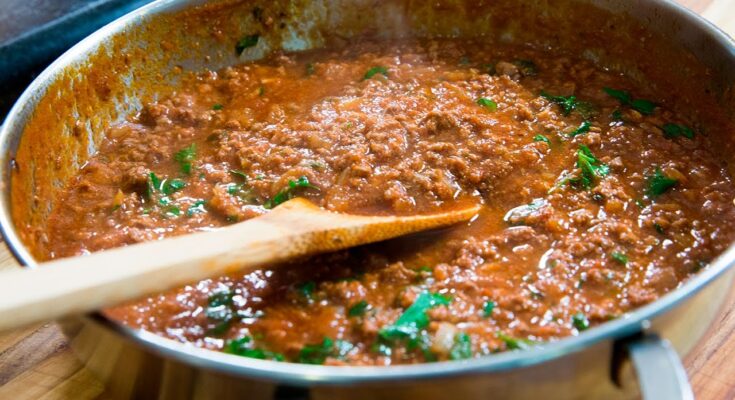Meat Sauce Recipe: Who doesn’t love a hearty, flavorful meat sauce? It’s the perfect companion to pasta, a critical ingredient for lasagna, and a crowd-pleaser at family dinners.
Sure, you could grab a jar from the store, but nothing beats the rich flavor of a homemade meat sauce. It’s not just a recipe—it’s a gateway to comfort food heaven.
Ready to dive in? Let’s make the best meat sauce you’ve ever had.
Ingredients for a Perfect Meat Sauce
Key Ingredients
- Ground Meat: Use beef for classic flavor, pork for richness, or a mix for the best of both worlds.
- Tomatoes: Canned crushed tomatoes are ideal, but you can also use tomato paste or fresh tomatoes for a more robust sauce.
- Onion and Garlic: These aromatic staples add depth to your sauce.
Optional Ingredients
- Vegetables: Add finely chopped carrots and celery for a hint of sweetness and complexity.
- Spices and Herbs: Oregano, basil, thyme, and bay leaves make the sauce fragrant and irresistible.
- Red Wine: A splash enhances the sauce’s depth, but it’s entirely optional.
Tools You’ll Need
- Large skillet or Dutch oven
- Wooden spoon or spatula
- Measuring cups and spoons
- Knife and cutting board
Preparation Steps Before Cooking
Gathering and Measuring Ingredients
Before you start cooking, ensure all your ingredients are ready to go. This keeps the process smooth and stress-free.
Prepping the Vegetables
Dice the onion, mince the garlic, and if you’re adding carrots or celery, chop them finely to blend into the sauce.
Preheating Equipment
Heat your skillet or Dutch oven over medium heat. A properly heated pan ensures the meat browns perfectly.
Cooking the Meat Sauce
Browning the Meat
Add a splash of oil to your preheated pan and toss in the ground meat. Cook until it’s browned and no longer pink. Drain any excess fat to prevent a greasy sauce.
Sautéing Vegetables for Extra Flavor
In the same pan, sauté your onion and garlic until they’re soft and aromatic. If using carrots and celery, add them now for a richer base.
Building the Sauce
Pour in the tomatoes, stir in your herbs and spices, and add wine or stock if you’re using them. Bring the mixture to a gentle boil before reducing the heat to a simmer.
Simmering for Maximum Flavor
How Long to Simmer
Let the sauce simmer on low for at least 30 minutes. The longer it simmers, the more the flavors meld together.
Adjusting the Sauce Consistency
If the sauce is too thick, add a splash of water or stock. If it’s too thin, let it simmer uncovered to reduce.
Serving Suggestions
Pairing with Pasta
Classic pairings like spaghetti or penne work wonderfully. Toss the pasta in the sauce for the best flavor distribution.
Using the Sauce in Other Dishes
Get creative! Use the sauce in:
- Lasagna for a rich layer of flavor.
- Stuffed peppers for a hearty dinner.
- As a pizza topping for homemade pies.
Storing and Reheating Meat Sauce
Storing in the Fridge
Allow the sauce to cool completely before transferring it to an airtight container. It stays fresh for up to 4 days.
Freezing for Later
Pour the sauce into freezer-safe containers or bags, leaving space for expansion. It can be frozen for up to 3 months.
Reheating Tips
Thaw frozen sauce overnight in the fridge. Reheat on the stovetop over low heat, stirring occasionally.
Tips for Customizing Meat Sauce
Substitutions and Variations
- Swap beef for ground turkey or chicken for a lighter sauce.
- Use plant-based meat for a vegetarian option.
Adding Heat for Spicy Sauce Lovers
Throw in red pepper flakes or diced chili peppers for an extra kick.
Making It Vegetarian
Skip the meat and load up on vegetables. Mushrooms, zucchini, and bell peppers are excellent choices.
Common Mistakes to Avoid
Overcooking or Burning the Sauce
Always keep the heat low and stir frequently to avoid scorching.
Using Too Much Liquid
Stick to the recipe proportions to avoid a watery sauce.
Forgetting to Season Properly
Taste as you go and adjust seasoning to suit your preferences.
FAQs about Meat Sauce Recipe
What type of meat is best for meat sauce?
For a rich and flavorful meat sauce, ground beef is a popular choice due to its fat content, which adds flavor and moisture. However, you can also use ground pork, turkey, or a combination of meats for different flavors and textures.
Can I make meat sauce in advance?
Yes, meat sauce is a great make-ahead dish. It often tastes better the next day as the flavors have more time to meld together. Simply store it in the refrigerator in an airtight container for up to three days, or freeze it for up to three months.
How can I thicken my meat sauce?
If your meat sauce is too runny, continue cooking it uncovered over low heat to allow some of the liquid to evaporate. For a quicker fix, you can stir in a small amount of tomato paste or a slurry made from cornstarch and water to reach your desired consistency.
What herbs and spices go well in a meat sauce?
Classic herbs and spices for meat sauce include basil, oregano, thyme, and bay leaves. Garlic and onions are essential for a flavorful base, while red pepper flakes can add a bit of heat. Feel free to experiment with other spices like paprika or fennel seeds to tailor the sauce to your taste.
Is meat sauce suitable for vegetarians?
Traditional meat sauce is not suitable for vegetarians as it contains meat. However, you can make a vegetarian-friendly version using plant-based meat substitutes or by increasing the amount of mushrooms, lentils, and diced vegetables to mimic the texture and heartiness of meat.
Can I use canned tomatoes for making meat sauce?
Absolutely! Canned tomatoes are a convenient and flavorful option for making meat sauce. Whole peeled tomatoes can be crushed by hand or blended for a smoother sauce, while diced tomatoes provide a chunkier texture. Tomato paste is also commonly used to enrich the sauce’s flavor and thickness.
Conclusion
Congratulations! You’ve mastered the art of making a rich, flavorful meat sauce from scratch. It’s a recipe that’s easy to customize and a delight to share. Your homemade sauce is sure to impress at any meal, whether it’s a simple pasta dinner or a special lasagna night.



